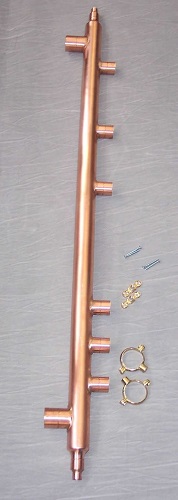What Is a Low Loss Header? How They Work & Uses

Jump to:
What is a low loss header & how do they work?
A Low-loss header is not complex, it is a large box of water or a tube with flow and return connections, allowing heat and water to flow.
You might be wondering how boilers supply heat to an entire office building or how giant heated premises like care homes or hospitals are heated. In some instances, a big commercial boiler is used, while in other cases, various boilers can be connected using a device known as a low-loss header.
The primary purpose of a low-loss header is to allow hydraulic separation between the heating circuit and the boiler. In addition, the low-loss header helps improve the efficiency and performance of the central heating system. Also, it regulates the system’s pressure and flow rate.
Below, we explain a low-loss header, how it works, and if you need one.
Get an online fixed price in 20 seconds:
What does a low-loss header do?
You need to install a low-loss header to ensure the high flow rate of water creates the heat needed for a big residential or commercial building and multiple buildings, like an office complex.
It upsurges the water flow that passes through the second heating circuit and adds water from the primary boiler circuit.
The boiler companies determine a standard boiler’s minimum and maximum flow rate. However, since it is directly attached to the heating system, it embraces a variable flow rate. Multiple control valves generally dictate this.
While there are numerous boilers in one system, a low-loss header regulates the flow rate, making the system inexpensive. This leads to a higher-performing, more effective boiler with a better water temperature that reaches your radiator.
However, a header won’t work well if a suitably sized pump is not installed. If the pump size is small, the hot water created by the appliance cannot reach the radiators far from the boilers.
Likewise, if the pump is too big, it might start pushing hot water around the radiators swiftly, wasting energy. So, two pumps are needed—the first from the boiler to the low-loss header and the second from the header to the system.
Why use a low-loss header?
You should use a low-loss header if you have a big home or commercial building and a boiler with low water content. Your header needs to be the ideal size for the building, and that depends on the water flow rate around the building.
Another great advantage of a low-loss header is to remove sludge and debris from your central heating system. Dirt enters your system from the water or main water supply and is stored in the cold feed tank.
In addition, the pipes in the system may start to corrode, resulting in a build-up of dirt. If this builds up a lot, it will hinder your radiator’s capability to heat properly. To keep an eye on that, check if your radiators are cold at the bottom. If they are cold, you might have sludge present.
A low-loss header normally contains a drain at its bottom. Hot water passes through the low-loss header with a low pressure compared to what would pass through the rest of the heating system. That reduction in speed and pressure allows time for debris in your system to sink to the bottom of the low-loss header.
To avert that, the drain in the low-loss header can be opened frequently to remove any dirt from the header. This allows your heating system to keep working efficiently and for a longer time.
Did you know a boiler service keeps your boiler efficient? See how much a boiler service costs in our price guide.
How does a low-loss header work?

A low-loss header works because there is a primary circuit and a secondary circuit in a boiler system. The primary circuit produces the actual heating of the water; thus, a pump and a boiler are included in this circuit.
The secondary circuit includes components that transfer energy or heat. In the case of a heating system, this can be underfloor heating or radiators.
A header can combine these two. The primary water flows into the header to provide heated water in the secondary circuit—offering the precise flow rate needed for the system.
A low-loss header is used alongside the rest of the system. Therefore, you need to consider other factors. If no pump is available in the system, it should be added. In addition, consider the min and max flow rates of the primary circuit. Also, the systems installed on the secondary circuits include underfloor heating.
Please read our information on other technical systems like the S-plan heating system.
What exactly is a low-loss header?
As mentioned earlier It is a large water container or tube with flow and returns connections that allow water and heat to flow through it.
What are the pros of a low-loss header?
After installing a low-loss header, you get the following advantages:
Constant flow
By dividing the system into two circuits, primary and secondary, the header makes boilers work at a constant flow rate in the main circuit. In contrast, flow rates and temperatures vary in the secondary circuit.
This averts any contact between these circuits and lets the primary circuit return temperature to show the maximum/overall load on the heating system.
Long boiler life
By making the flow rate smooth, a header ensures that the system’s performance and efficiency are upgraded, and the boilers are protected from irregular flows, eventually enhancing the boilers’ life. Another way to ensure that your boiler last longer is to get an annual boiler service.
Clean systems
If the low-loss header is installed vertically, it helps gather sludge from the heating system. However, we would still advise you to clean your existing systems and minimize dirt and debris in the water.
In addition, dedicated dirt and air separator should be installed on the heating system or the low-loss header with integrated dirt and air separation should be used.
Air venting
When the header is installed in a vertical direction, the air is released due to low flow velocity—where the flow of water slows down, and the variation in pressure release air and then increases in the low loss header and can be removed easily via the automatic air vent.
Conclusion
Low-loss headers are efficient for mixing flow and return, which results in temperature changes. Therefore, you should consider your system’s overall design and controls for maximum positive outcomes.
Also, a header will work correctly only if you have installed a precise pump size in the system. If not, the system will waste energy, make noise, and affect the primary flow rate by disabling the neutral effect created by the low-loss header.
In addition, you need to consider the cost of changing your existing system by installing a low-loss header. The costs can be higher or lower depending on your heating requirements.
Moving forward, be mindful of the space needed for installing a low-loss header. The connected pipework might not allow you to accommodate the extra equipment.
Looking for a powerful boiler? Check out the latest new boilers at Boiler Central by using our online quote tool now


